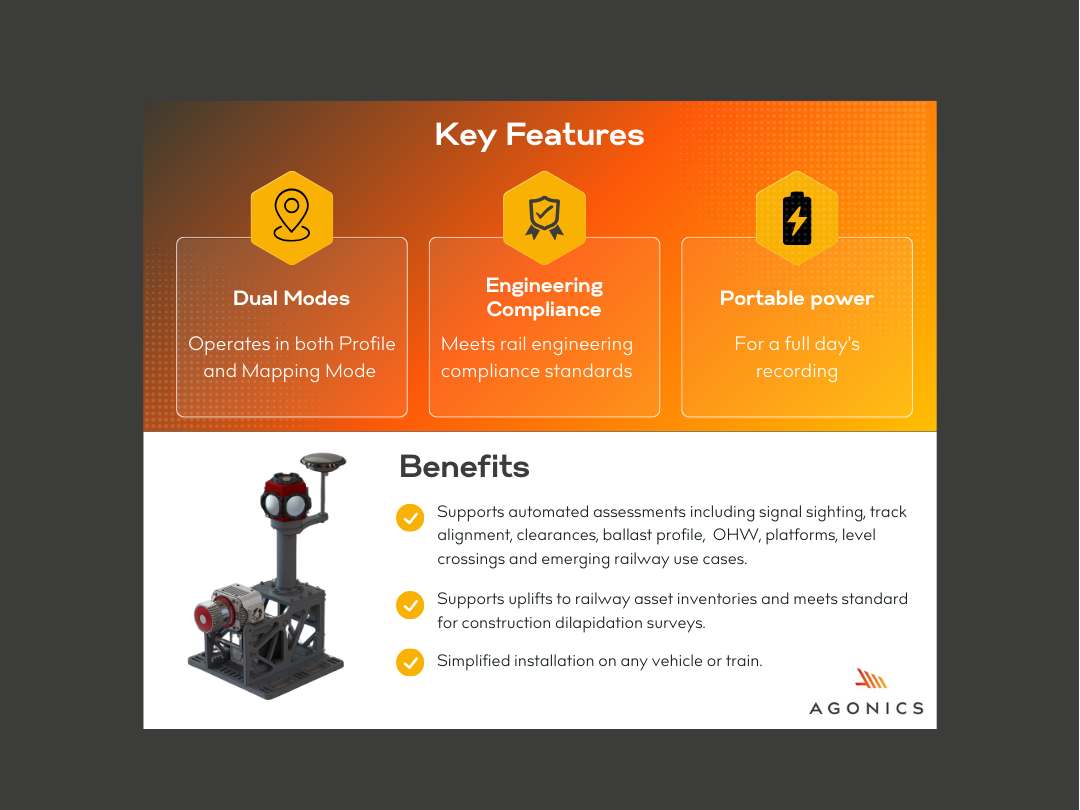
At Agonics, we have developed our own Mobile Laser Scanning (MLS) system to enhance our offerings in the Rail industry. To learn more about this innovative system, we interviewed Mark Merida, one of our Directors who has played a key role in its development.
Can you introduce yourself and your role in the development of our in-house MLS system?
My name is Mark Merida. I am one of the Directors at Agonics overseeing project delivery and technology. I have been leading the design, procurement, construction, and testing of our own in-house MLS system, collaborating closely with our technical team and local suppliers.
What was the motivation or need behind creating this MLS system internally?
Our team has extensive experience in the Rail and Power industries working with aerial, mobile, and terrestrial scanning technology and so we work with a lot of data generated by MLS systems. We routinely see how some MLS systems let clients down with data outputs that severely limit how many rail engineering use cases can actually be addressed. We also see MLS systems that produce datasets in proprietary formats, and this can make post processing quite painful. We wanted therefore to build our own MLS system to have the flexibility to select components based on hardware capabilities and software workflows. Additionally, we wanted our MLS system to function both as a profiling system and as a mapping system as our rail clients are always challenging us with new use cases for LiDAR data.
What are the key features of our MLS system that set it apart from others?
Our MLS operates in two modes. The profile mode helps rail customers with rail alignment and clearance measurement workflows. The mapping mode allows the Inertial Measurement Unit and Scanner to be pitched up to 30 degrees producing a detailed point cloud similar to current off-the-shelf MLS systems. Our system is also designed to meet engineering compliance standards for rail environments. This is a key differentiator because we have worked with local design experts to come up with a design that is flexible for different types of rail deployments. It’s really quite special actually because this design is unique to us, and we have invested many hours of thought into getting this right!
What specific benefits does our MLS system offer to clients?
The profiling mode supports engineering level measurements required to support rolling stock clearance assessments, platform height and offset, ballast profile and track alignment measurements to name just a few use cases we regularly report on. The mapping mode feature supports signal line of sight, level crossing sighting distance analysis and Enterprise Asset Management data uplift workflows.
Can you share any challenges faced during development and how they were addressed?
A major challenge was providing clean power to all components, including computer hardware. Advances in battery technology now offer portable power stations capable of powering an MLS system for a full day’s rail corridor recording, eliminating the need for a vehicle power source and simplifying installation.
Are there any upcoming features or enhancements planned for our MLS system?
We are considering adding additional cameras such as line scan to enhance the system.
Can you share any success stories or examples of how clients have benefited from using our MLS system?
Yes, we have recently completed a number of projects in Australian using the new MLS system. We made a post quite recently actually on our project on the beautiful West Coast Wilderness Railway in Tasmania, so it has actually already been ‘overseas’.
Based on your experience, what advice would you give to other companies considering developing their MLS system in-house?
Come and talk to us! The LiDAR industry in Australia is robust, partly due to our remoteness and size. The industry has learnt many lessons using this technology in some of the worlds harshest conditions. We’d suggest that you collaborate with suppliers who are often willing to go above and beyond to support your vision. If you like what you read, we can always custom build a system for you, just get in touch.
Featured project:
West Coast Wilderness Railway Project
In May 2024, the Agonics team achieved a unique milestone by successfully capturing LiDAR data and imagery along the 35km stretch of the West Coast Wilderness Railway (WCWR), which runs from Strahan to Queenstown, through the captivating rainforest of Tasmania’s west coast.
The WCWR, one of the rare operational rack and pinion railways, features a distinctive third central rail with vertical teeth engaging cog wheels beneath the locomotive. The historical… Read more